Please choose your country or region so we can show you the most relevant content.
It looks like you are in United States? Accept
Africa
- Algeria
- Angola
- Benin
- Botswana
- Burkina Faso
- Burundi
- Cabo Verde
- Cameroon
- Central African Republic
- Chad
- Comoros
- Congo
- Côte d'Ivoire
- Djibouti
- DR Congo
- Equatorial Guinea
- Eritrea
- Eswatini
- Ethiopia
- Gabon
- Gambia
- Ghana
- Guinea
- Guinea-Bissau
- Kenya
- Lesotho
- Liberia
Asia
Australasia
Europe
- Albania
- Andorra
- Austria
- Belarus
- Belgium
- Bosnia and Herzegovina
- Bulgaria
- Croatia
- Czechia
- Denmark
- Estonia
- Finland
- France
- Germany
- Greece
- Greenland
- Holy See
- Hungary
- Iceland
- Ireland
- Italy
- Latvia
- Liechtenstein
- Lithuania
North America
Middle East
We call our Nordic tipis “A home from home”. A development of the traditional Sami “kåta”, it has been used as a home, not a shelter, by generation after generation. And it continues to be so. Here on Tentipi we get reports from people spending years in their tents. Like Laura and Jarmo Järvinen who stayed 12 month on an island in the archipelago of Åboland in the south of Finland in their Safir 9 cp. Or the promising ultrarunner Markus Torgeby who grew sick of the pressure and moved out in the forests of central Sweden, staying in a in a Granit 14 for four years. There’s just something about getting away from it all, getting back to the basics, isn’t it?
In this episode of the Tentipiblog we meet Gina and Koen who made the quite unorthodox decison to move out into a Safir 9 cp, still keeping their regular day-to-day at their offices.
We have this rhythm. It was never something that we agreed upon. It just evolved through repetition.
Koen is in charge of the stove, dismantling, emptying and cleaning it, while I pack – arranging the items with tetris like precision so that our lives fit neatly in the boot of the car. I consider it an art form.
We would move through this process every few days, sometimes every day, occasionally swapping roles, but always returning to the same rhythm. One day we timed it: we could disassemble camp in 30 minutes flat.
We did this for a year. A Wild Year.
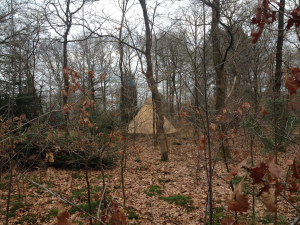
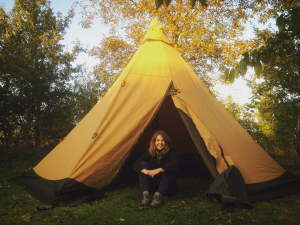
It was an idea inspired by the founding fathers of the conservation movement, Thoreau, Leopold and Muir, to try and better understand how we connected with the natural environment. In his book Walden Thoreau wrote: “Live in each season as it passes; breathe the air, drink the drink, taste the fruit, and resign yourself to the influence of the earth”, and after studying and teaching in nature conservation for over 10 years we started to put theory into practice on a daily basis.
Originally, we had wanted to follow in Thoreau’s footsteps, head off for the wild and spend a year building a life from scratch.
But, there was a catch. Our work is also important to us; it was not something we wanted to step away from for a year. In September 2016, we had just returned to Europe from a six-month journey that began in Brazil and ended in Canada. We had camped most of the way, and talked at length about the possibility of prolonging our time under canvas. We wanted to achieve balance, ensure that we did not just talk and lecture on the virtues of a connection with the natural world, but actively practice what we preached.
This became the momentum for the Wild Year. What if we could take the idea behind the 19th century log cabin in the woods and apply it to a modern day setting. Could we keep working and spend a decent proportion of our time outside? What would a decent proportion be? We figured it had to be marked by a majority, so it had to be 50% or more.
And, when you calculate in the amount of time spent on work, the logical way to achieve 50% of your time out of doors is to sleep outside.
So, that was what we did.
Throughout the Wild Year we slept under canvas, tarps, mossie nets, and when possible, nothing at all. But, our base was the tipi – or TipiHQ as it became fondly known.
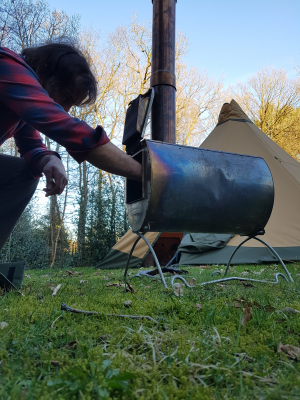
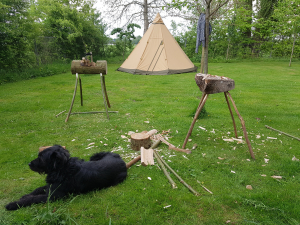
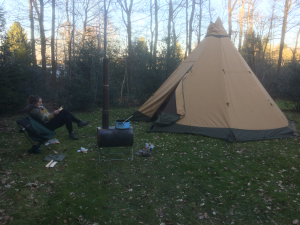
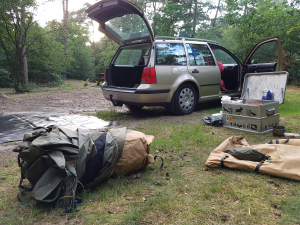
We were drawn to the idea of tipi after spending a night in one owned by a member of the Maliseet First Nation in Canada. Sat around a fire, and with the flickering flames that made the painted handprints of friends and family dance across the canvas, we experienced a warm cosiness that we thought we could happily endure.
When we returned to Europe we looked for a modern equivalent and that was when we stumbled across Tentipi. We were drawn to the well-considered design, inspired by the Sami culture. We chose a Tentipi Safir 9 cp together with the Eldfell stove for the space and warmth that they provided.
In addition to the tipi and the stove our core kit consisted of a rubber groundsheet, a pair of inflatable field mattresses tied together with paracord, a down duvet, two foldable chairs and an old metal army box that contained essential kitchen equipment and food. We would carry enough clothes for a few days, which did mean regular visits to family members and friends to ‘borrow’ a washing machine.
We camped up at locations close to our respective offices throughout the year, but always at ‘natural’ camping sites. This meant that facilities were basic – many of these sites operate on a community basis where users are responsible for cleaning and maintenance. We checked log piles, filled holes in paths and kept facilities clean. In the winter, there was usually only a single toilet available and one cold water tap, which made for short showers!
The bonus though was that in the cooler, wetter periods these places were rarely occupied and we often found ourselves nestled alone in green hotspots, neighbours to national parks, black woodpeckers and roe deer.
On one cool late winter evening we sat at a picnic bench in a deserted campsite. The pines hung overhead, silhouetted by a crisp moon encircled in an icy halo. We were donned in multiple layers, and I had an alpaca blanket underneath my coat for extra warmth – a habit that had been adopted as the winter weather set in. We knew that if we’d come back to a house that evening there would have been little chance of us deciding to dine out in the garden.
In ‘regular’ daily life it is easy for the outdoors to become a backdrop rather than an environment to be part of, but it is seemingly easy to rectify that disconnect with a welcome shift in routines.
The alpaca layer was one of the many tools for enjoying the winter weather. The cold had been one of my main concerns when we embarked on the Wild Year. Despite having camped in Patagonia and near Ushuaia (also known as The End of the World) in freezing temperatures, we knew the Netherlands was still able to offer its share of frosty nights that could creep right through the lining of a thick sleeping bag.
This initial concern was easily mitigated. During the first snowfall we sat with friends around the stove decked out in t-shirts. On a chilly evening we would have the stove going to cook and then we would usually stoke it before getting in to bed. By the time the fire had died out we would be warm enough in a down cocoon. For safety we always carried a carbon monoxide meter with us when we had the stove lit, but were always cautious about incomplete combustion and the wood we burnt, steering clear of damp log piles to avoid a build-up of carbon monoxide.
We honed many practical skills during our time in the tipi, refining our bushcraft techniques along the way – outdoor cooking, fire building, leaving no trace. However, this was an added bonus, not the intention, of our time outside. Which beggars the question: did it work? Did we manage to achieve a greater connection with the environment?
The answer, for both of us, is a resounding yes.
The Wild Year allowed us to slow down and switch off – or rather on.
We had less time to ‘do stuff’ each day because of the need to fulfil necessary tasks – building camp, making a fire, cooking – but this never felt like wasted time. Our setting differed every few days, from pine trees to willows, from riversides to open fields. The seasons changed and shifted, and us along with them.
The practical constraints of the wild year were minimal – the increased amount of travel, the stress of finding a camping spot in the middle of the city when work demanded it, the continuous packing – when compared with the benefits that the experiment brought: we felt healthier, we slept better, we attuned to a natural rhythm. We noticed when species arrived. When the morning alarm calls of the robin and the blackbird were accompanied by the geese overhead, followed by the storks and the cranes. And then, when they started to fade away again. We woke up warm in stifling summer heat, but struggled to get going when the sun stayed hidden behind the tree line during the winter months.
It was a year of rich and fulfilling time spent out of doors. A year that brought adventure into the everyday. A year that showed us how to “live in each season as it passes; breathe the air, drink the drink, taste the fruit, and resign [ourselves] to the influence of the earth”.
Gina and Koen ended the Wild Year after 379 consecutive nights outside, in the beginning of October 2017. They are currently on the lookout for a more permanent base, not necessarily indoors. Meanwhile, the Tentipi Safir 9 cp is artfully packed, awaiting the next adventure.
Related blog posts
Wouldn't it be exciting to spend the night right in the middle of a zoo? – That is exactly what you can do at Skånes Djurpark, a wildlife park in southern Sweden. At their campsite, Camp Oak, you stay in the park after it closes and will make yourself at home in a Nordic tipi from Tentipi. When the night comes you might just fall asleep to the wolves’ howls.
Skånes Djurpark is a Wildlife Park with a long history, it dates back to 1952. It focuses on animals from the Nordic area and has always lived by the ruling with “no animals in cages”. The animals live in large paddocks that recreates the animals’ natural environments.
Sapmi Nature Camp – Sami culture and glamping in the arctic
木曜日 30 12月 2021
Lennart Pittja is a Sámi entrepreneur with a mission: with his world-renowned eco-tourism company he wants to spread the knowledge about his people – the Sami, indigenous of northern Scandinavia and Russia. With over 20 years of experience as a wildlife guide and nature photographer in the arctic region he started Sápmi Nature Camp. Where his guests stay in Nordic tipis from Tentipi on his reindeer herding land outside of Gällivare, in northern Sweden.
At Sapmi Nature camp you can experience real winter, see the northern lights, eat traditional Sami food, and have a cultural exchange in a genuine atmosphere. The scenic location has gained attraction from around the world. In 2017 it was listed by National Geographic as one of the top 21 places in the world to visit if you care about the planet.
Discovering the world’s most remote places with Mike Fuchs
木曜日 17 6月 2021
It was the first day of the trip, adventurer Mike Fuchs and his friend Eric Folz had just a couple of hours before been dropped off as far north as they could possibly come in Svalbard when they saw them. Two polar bears, one mother and its cub. A situation that could become deadly if the bears decided to have a closer look on their new visitors.
“I know how protective the mothers can be of their cubs. We had to set up our camp in a place that provided a good overview of the location so we could spend the night bear watching. It was both a scary feeling seeing them so early into our trip, but it was also very fascinating”, says Mike Fuchs.
Nine things you need to know about winter camping
水曜日 5 5月 2021
Prepare before setting out for winter camping. Here are nine tips and tricks from Tentipi about what you need to think of before you go: the right tent for winter camping, how to pack the snow, comfort in snow, which tent pegs to use, where to pitch the tent, about snow weight, what heat sources can be combined with the tent, how to make a fire safely and other equipment.
Choose tents according to occasion, different tent types work differently at winter camping. When it’s icy, the tent needs to be more robust than a tent which is exclusively used in summer. The tent frame needs to withstand a certain amount of snow and functional ventilation is important. If you want to use a heat source, for example a fireplace or a stove, the tent needs to have ventilation openings both at ground level and at the top. Without a heat source, a smaller tent is preferable, as it heats up faster when the air volume is smaller.
A tent from Tentipi is a Nordic tipi and the tent has eight or nine sides, if it is not the smallest that has six sides. In the smallest tent you can stand straight if you are less than 160 centimetres long and in the largest you can get together several thousand people. The tent is versatile in more ways. Continue to read to see why these tents are so flexible and adaptable. This blog post is about the smaller tents in Tentipi's range, tents used by adventurers, families, hikers and others who want to live close to nature for a shorter or longer period of time.

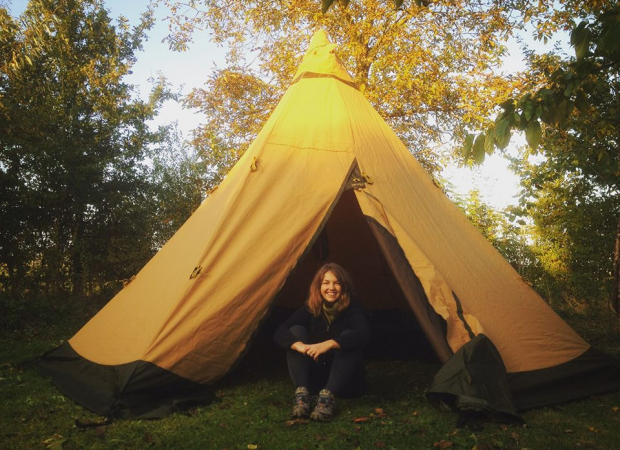





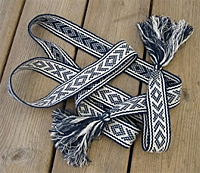


I really like this blog post, I look forward to trying out an adventure like this myself!